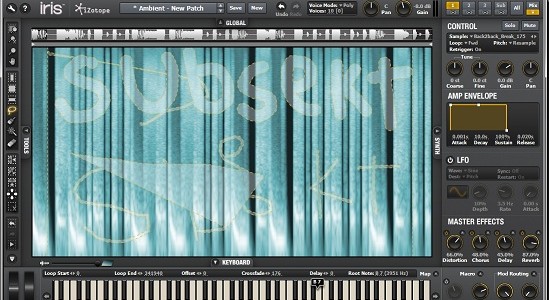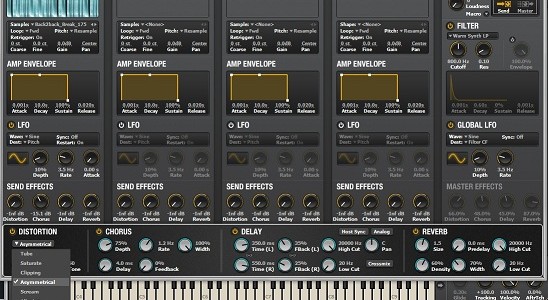Izotope Iris _ Review
Ok – Izotope Iris has been out a while, but it’s definitely the type of plugin that is worth reminding everyone about on a regular basis.
With endorsements by the likes of Brian Eno, how can mere mortals refuse an opportunity to investigate further?
Iris is a sound designer’s wet dream. One can literally load in any audio source and in less than a minute, have mangled that into something that wouldn’t sound amiss darting around in a Hollywood movie. The process and results are THAT immediate, producing a rich palette of sounds from the most (seemingly) banal of original sources.
The origin of Iris comes from the spectral editing / audio restoration software RX2. Unlike “normal” samplers (Iris deals in “Resynthesis”), the GUI allows you to view both the waveform AND the spectrogram simultaneously, which proves very exciting as you can pinpoint, select and manipulate pretty much any aspect of the given sound. To explain, let’s consider a field recording of street sounds. Iris lets you pretty much isolate the background parts, such as passing speech or distant accelerating, cutting out most of the obviously dominant sounds in the foreground. It’s not pristine by any means.. but that is not the aim.
Add some imagination and you’ve got a pretty good idea of how addictive something like Iris is. I also tried it on an old jazz tune (Iris does not import MP3) and was able to select the area around the vocal. Though the result was by no means an acceptable acapella, for pulling out a particular word or phrase, it certainly produces rough and usable otherworldly vibes. Smoother results may be possible with greater time, but I was happy with the uniqueness of what it produced.
As mentioned before, using Iris is very immediate. The interface is intuitive and features elements that are common and expected in your usual sampler / synth / DAW. To get deeper on a vanilla sample, you may use the selection and paint tools, to select and create new waveforms out of any material. What’s very cool is being able to paint or draw in the waveform, similar to a midi clip or step sequencer. Though a long brush stroke typically results in a nice smooth sound, interesting rhythms can be got by adding extra dots (or notes if you will..) around the spectrogram.
The structure of a patch consists of 3 layers to add samples and a fourth sub layer, which is limited to Iris presets only. The individual “sample layers” are pretty flexible, allowing you to loop sections of audio and play forwards, backwards, forwards backwards or in reverse and so on. A cool little feature, this setting allows for different play styles on the individual layers, enabling more complicated, evolving sounds to develop after the initial layer is heard.
With Iris, you get distortion, chorus, reverb and delay as sends on each layer and the quality of these effects are excellent in tone. The reverb is particularly lush and smooth. Also noteworthy are the 6 distortion types available; ranging from tube-y to destructively rude. It is worth pointing out that the effects mode can be toggled from master to send on the main mixer page.
Every channel has an amp ADSR and a LFO, with the latter being available to modulate the amp, pitch or pan. The mod routing section allows for things like velocity and aftertouch to affect master cut off and LFO, revealing one of Iris’ rare weak points. Not only would you expect each layer to have its own basic EQ or filter, but it’s probably reasonable to imagine that greater modulation options should be available. Individual filters alone and the ability to mod them would have been a great bonus..
Compared to Ableton’s Sampler instrument, it certainly feels lacking in that respect; but then again, Sampler does not sound like Iris and Iris is not trying to be a traditional sampler. However, it remains my only real bugbear. Hopefully subsequent versions will bring additional options or at least expand the existing ones to include, sample playback characteristics, fx modulation, and look, while we’re making a list; extra envelopes and LFO’s anyone?
The 4 layer channels are flanked by a well organised mixer page, which functionally presents each of the individual channels in one place, along with access to the effects and master filter and envelope and master LFO that is assignable to amp, filter and pan. The sound of the filter is great and there are 8 different models available to shape and colour the sound.
Overall, Iris is a very inspirational instrument. Its ease of use and overall ergonomic functioning is impressive given the sonic results and the potential that there could have been to complicate the GUI. It’s an accomplishment to be proud of. It’s a small feature, but I love how you can double click on a knob ad it’ll return to its default value. Very thoughtful.
Sitting down with it at the start, I chose to import my own sounds and get a feel for what it was capable of rather than diving right into the presets. Deep basses and interesting ear candy can easily and satisfyingly be created out of nothing.
After a while, I wondered if Iris could sound too like Iris. Time to hit the 4gb library!
I soon realised that selective modulation and creative use of effects, could achieve a vast array of sounds (ranging from standard to scratch yer head). Really the only static thing in this situation was my own imagination and approach.
Iris invites you to step out of your comfort zone. The initial instinct or pressure with this software is to create something bizarre, however it shines just as brightly when used to create straightforward sounds. Though packed full of incredible sounds (and many extra libraries are available to purchase), I would definitely recommend that the library is treated as a learning tool in order to discover the strengths of Iris.
I can’t help but feel that this is just the beginning of Iris’ development and undoubtedly the next installment will be just as enjoyable as the first. Be assured that this is a perfect tool for anyone looking to inject some unique angles into their music.
Iris, with a strong sound, excellent inbuilt effects and immediate simplicity recommends itself.
And it’s really a lot of fun. Grab the demo and you’ll see..
_________________________



